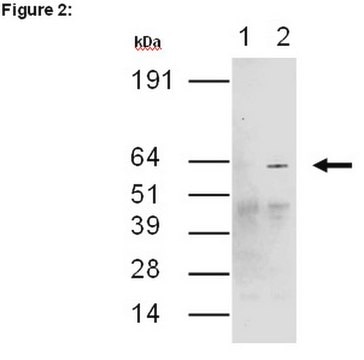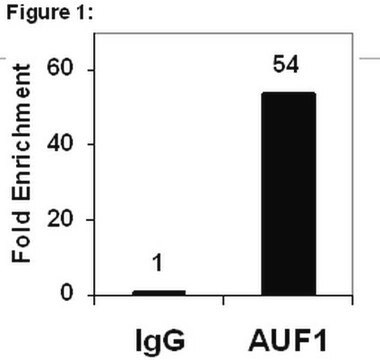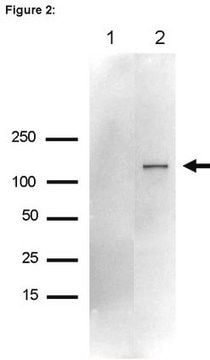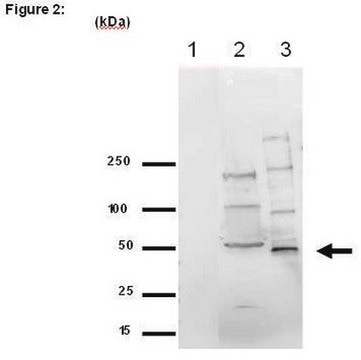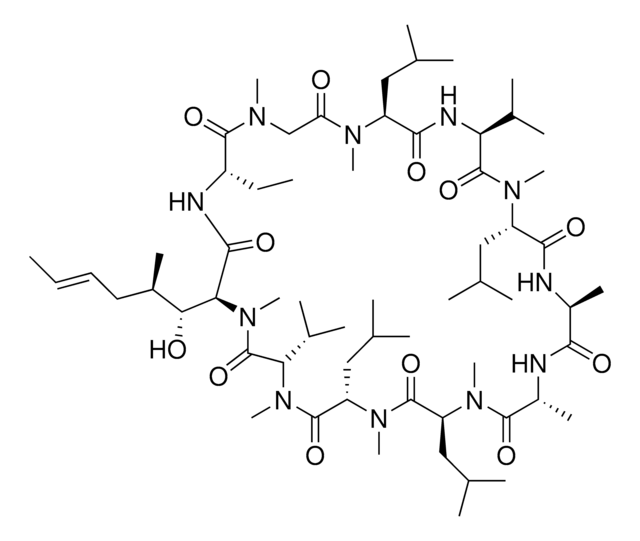03-102
RIPAb+ HuR - RIP Validated Antibody and Primer Set
from rabbit
Synonym(s):
ELAV-like protein 1, Hu-antigen R
Sign Into View Organizational & Contract Pricing
All Photos(5)
About This Item
UNSPSC Code:
12352203
eCl@ss:
32160702
NACRES:
NA.32
Recommended Products
biological source
rabbit
Quality Level
clone
polyclonal
species reactivity
mouse, human, rat
manufacturer/tradename
RIPAb+
Upstate®
technique(s)
RIP: suitable
immunocytochemistry: suitable
immunohistochemistry: suitable
immunoprecipitation (IP): suitable
western blot: suitable
NCBI accession no.
UniProt accession no.
shipped in
dry ice
Gene Information
human ... ELAVL1(1994)
General description
RIPAb+ antibodies are evaluated using the RNA Binding Protein Immunoprecipitation (RIP) assay. Each RIPAb+ antibody set includes quantitative RT-PCR control primers (RIP Primers) to biologically validate your IP results by successfully coprecipitating a specific RNA target (where such a specific target is known). The qPCR protocol and primer sequences are provided, allowing researchers to validate RIP protocols when using the antibody in their experimental context. Each set also includes a negative control antibody to ensure specificity of the RIP reaction.
The RIPAb+ HuR set includes the HuR antibody, a negative control antibody (purified Rabbit IgG), and positive qPCR primers which amplify a 100 bp fragment of the human beta actin (ACTB) cDNA. The HuR and negative control antibodies are supplied in a scalable "per RIP" reaction size and can be used to functionally validate the precipitation HuR-associated RNAs.
The RIPAb+ HuR set includes the HuR antibody, a negative control antibody (purified Rabbit IgG), and positive qPCR primers which amplify a 100 bp fragment of the human beta actin (ACTB) cDNA. The HuR and negative control antibodies are supplied in a scalable "per RIP" reaction size and can be used to functionally validate the precipitation HuR-associated RNAs.
Immunogen
Epitope: a.a. 1-13 of HuR
Application
Immunoprecipitation from RIP lysate:
RIP lysate from MCF7 cells (2 X 106 cell equivalents per IP) was subjected to immunoprecipitation using 0.5 μg of either a normal rabbit IgG or Anti-HuR antibody. Precipitated proteins were resolved by electrophoresis, transferred to nitrocellulose and probed with anti-HuR (1.0 μg/mL).
Proteins were visualized using One-Step IP-Western kit (GenScript Cat. # L00231) (Please see figures).
Western Blot Analysis:
3T3/A31 lysate was resolved by electrophoresis, transferred to PVDF membranes and probed with HuR, hu (1:500 dilution). Proteins were visualized using a Donkey anti-Rabbit conjugated to HRP and visualized using a chemiluminescence detection system. (Please see figures).
Immunoprecipitation Analysis:
10 ug of this antibody immunoprecipitated HuR from 500 ug of 3T3/A31 RIPA lysate (Please see figures).
mmunocytochemistry Analysis:
Confocal IF analysis of HeLa, NIH/3T3 using anti-HuR (Red). Actin filaments have been labeled with AlexaFluor 488 -Phalloidin (Green). Nucleus is stained with DAPI (Blue) (Please see figures).
RIP lysate from MCF7 cells (2 X 106 cell equivalents per IP) was subjected to immunoprecipitation using 0.5 μg of either a normal rabbit IgG or Anti-HuR antibody. Precipitated proteins were resolved by electrophoresis, transferred to nitrocellulose and probed with anti-HuR (1.0 μg/mL).
Proteins were visualized using One-Step IP-Western kit (GenScript Cat. # L00231) (Please see figures).
Western Blot Analysis:
3T3/A31 lysate was resolved by electrophoresis, transferred to PVDF membranes and probed with HuR, hu (1:500 dilution). Proteins were visualized using a Donkey anti-Rabbit conjugated to HRP and visualized using a chemiluminescence detection system. (Please see figures).
Immunoprecipitation Analysis:
10 ug of this antibody immunoprecipitated HuR from 500 ug of 3T3/A31 RIPA lysate (Please see figures).
mmunocytochemistry Analysis:
Confocal IF analysis of HeLa, NIH/3T3 using anti-HuR (Red). Actin filaments have been labeled with AlexaFluor 488 -Phalloidin (Green). Nucleus is stained with DAPI (Blue) (Please see figures).
This RIPAb+ HuR -RIP Validated Antibody & Primer Set conveniently includes the antibody & the specific control PCR primers.
Quality
RNA binding protein Immunoprecipitation:
RIP Lysate prepared from HeLa cells (2 x 107 cell equivalents per IP) were subjected to immunoprecipitation using 5 µg of either a normal Rabbit IgG or Anti-HuR antibody and the Magna RIP Kit (Cat. # 17-700).
Successful immunoprecipitation of HuR-associated RNA was verified by qPCR using RIP Primers, ACTB (Please see figures).
Please refer to the Magna RIP® (Cat. # 17-700) or EZ-Magna RIP (Cat. # 17-701) protocol for experimental details.
RIP Lysate prepared from HeLa cells (2 x 107 cell equivalents per IP) were subjected to immunoprecipitation using 5 µg of either a normal Rabbit IgG or Anti-HuR antibody and the Magna RIP Kit (Cat. # 17-700).
Successful immunoprecipitation of HuR-associated RNA was verified by qPCR using RIP Primers, ACTB (Please see figures).
Please refer to the Magna RIP® (Cat. # 17-700) or EZ-Magna RIP (Cat. # 17-701) protocol for experimental details.
Target description
35 kDa
Physical form
Anti-HuR (rabbit polyclonal). One vial containing 50 μg of purified rabbit polyclonal in 100 μL of buffer containing PBS in 0.05% sodium azide with 50% Glycerol. Liquid at -20°C.
Normal Rabbit IgG. One vial containing 125 μg purified rabbit IgG in 125 μL storage buffer containing 0.1% sodium azide. Store at -20°C.
RIP Primers, ACTB. One vial containing 75 μL of 5 μM of each primer specific for human beta actin (ACTB). Store at -20°C.
FOR: TTG TTA CAG GAA GTC CCT TGC C
REV: ATG CTA TCA CCT CCC CTG TGT G
Normal Rabbit IgG. One vial containing 125 μg purified rabbit IgG in 125 μL storage buffer containing 0.1% sodium azide. Store at -20°C.
RIP Primers, ACTB. One vial containing 75 μL of 5 μM of each primer specific for human beta actin (ACTB). Store at -20°C.
FOR: TTG TTA CAG GAA GTC CCT TGC C
REV: ATG CTA TCA CCT CCC CTG TGT G
Format: Purified
Analysis Note
Control
Included negative control rabbit IgG antibody and control primers specific for human beta actin (ATCB).
Included negative control rabbit IgG antibody and control primers specific for human beta actin (ATCB).
Legal Information
MAGNA RIP is a registered trademark of Merck KGaA, Darmstadt, Germany
UPSTATE is a registered trademark of Merck KGaA, Darmstadt, Germany
wgk_germany
WGK 2
flash_point_f
Not applicable
flash_point_c
Not applicable
Certificates of Analysis (COA)
Search for Certificates of Analysis (COA) by entering the products Lot/Batch Number. Lot and Batch Numbers can be found on a product’s label following the words ‘Lot’ or ‘Batch’.
Already Own This Product?
Find documentation for the products that you have recently purchased in the Document Library.
Heat resistance of Bacillus spores when adhered to stainless steel and its relationship to spore hydrophobicity.
P Simmonds,B L Mossel,T Intaraphan,H C Deeth
Journal of Food Protection null
Jian Pu et al.
Frontiers in oncology, 11, 754835-754835 (2021-11-05)
Hepatocellular carcinoma (HCC) is one of the most aggressive malignancies. Increasing evidence revealed that long noncoding RNAs (lncRNAs) were frequently involved in various malignancies. Here, we explored the clinical significances, roles, and mechanisms of lncRNA ADORA2A antisense RNA 1 (ADORA2A-AS1)
Xiangbo Ruan et al.
Nature communications, 11(1), 45-45 (2020-01-04)
Unlike protein-coding genes, the majority of human long non-coding RNAs (lncRNAs) are considered non-conserved. Although lncRNAs have been shown to function in diverse pathophysiological processes in mice, it remains largely unknown whether human lncRNAs have such in vivo functions. Here
Fuzhen Qi et al.
Journal of hematology & oncology, 10(1), 48-48 (2017-02-18)
Long noncoding RNAs (lncRNAs) have emerged as important regulators of tumorigenesis and cancer progression. Recently, the lncRNA AGAP2-AS1 was identified as an oncogenic lncRNA in human non-small cell lung cancer (NSCLC) and its elevated expression was linked to NSCLC development
Daphna Nachmani et al.
Nature communications, 5, 4186-4186 (2014-06-14)
The recognition of stress-induced ligands by the activating receptor NKG2D expressed on cytotoxic lymphocytes is crucial for the prevention and containment of various diseases and is also one of the best-studied examples of how danger is sensed by the immune
Our team of scientists has experience in all areas of research including Life Science, Material Science, Chemical Synthesis, Chromatography, Analytical and many others.
Contact Technical Service